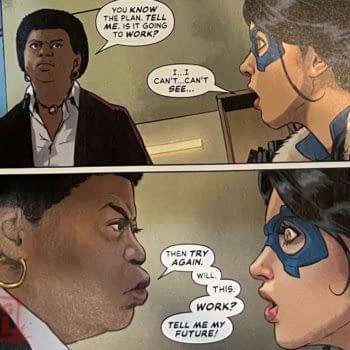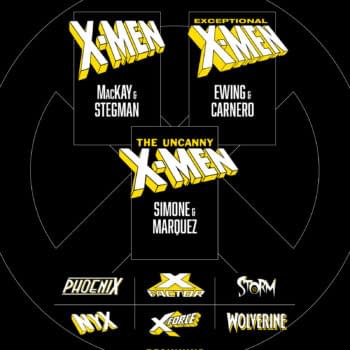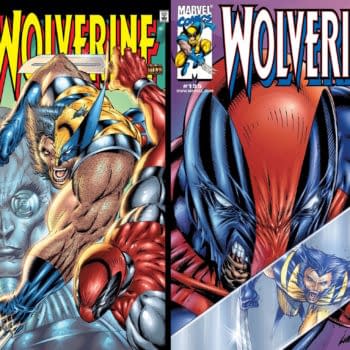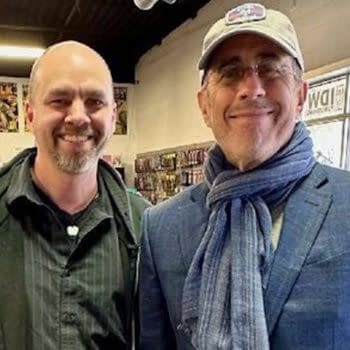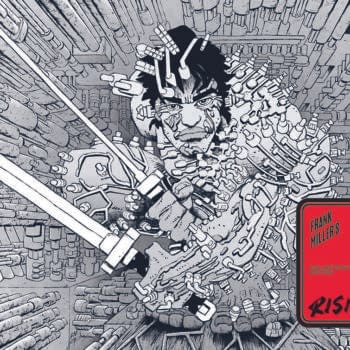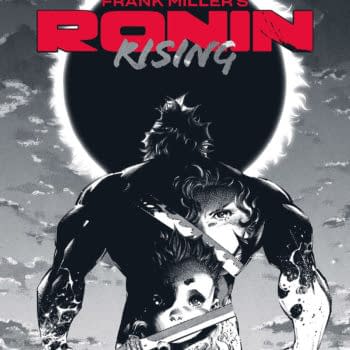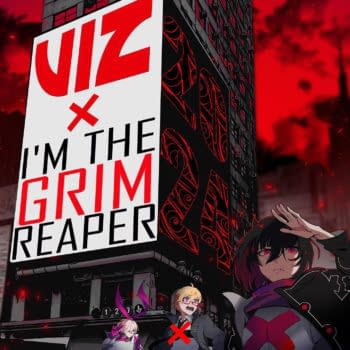Posted in: Comics | Tagged:
Daniel Warren Johnson On The Journey To Re-Inventing The Revenge Story With Extremity
Earlier this month at the Emerald City Comic Con in Seattle, Washington I had the pleasure to sit down with comic book creator Daniel Warren Johnson to talk about his journey as an artist and his his career in comic books.
Daniel's good-natured and gentle spirit was immediately evident as he took a seat at the table, as did his soft yet swift voice betray his New England roots. We jumped right in, exploring his introduction to comic books…
Daniel Warren Johnson: Probably my first introduction to the comic form was very early on with [Bill Watterson's] Calvin and Hobbes. I went to the public library in Framingham, Massachusetts, and they didn't have comic books. The only kind of comics they had were strips, like Far Side and Calvin and Hobbes, in the collected editions.
Dane Styler: I love Calvin and Hobbes. My favorite strips are the snowmen death scenes.
DWJ: Yes, those were my favorite too. I also loved when he would go into an alternate universe with the dinosaurs. When he pretended to be a T-Rex. He [Bill Watterson] would render the dinosaurs really well. It was gorgeous, and it was almost like a realistic dinosaur comic but then all of a sudden Calvin is at the end, like he was imagining all of it.
And there's no explanation. It is implied that he was pretending to be a T-Rex, and it was in a comic strip – he doesn't even need a bunch of pages to explain it. His presentation and visual style, even then, really resonated with me, as did his use of kinetic action. For example, when Hobbes tackled Calvin out of the door when home from school, his belly extends. It's almost as though he's an actual spring. It's so extreme and so expressive.
DS: So did reading Calvin and Hobbes inspire you to be drawing at an early age?
DWJ: Yes, I started drawing when I was in first grade. I would draw Power Rangers, because that helped me to be a little more popular with the cool kids in first grade, you know. There's a hierarchy in first grade.
DS: Was your drawing successful at getting you in with the cool kids?
DWJ chuckles: No… not really. I invited them to my birthday party too. And you know what's funny? They wouldn't invite me to their birthday parties, but I didn't even want to go to their birthday parties. I just wanted the Spider-Man invitations!
DS: So then at what point did you become more serious about your art? Was there anyone of influence when you were young?
DWJ: I was home-schooled from third through twelfth grade, because I wasn't doing super well in second grade, and I was getting beaten up a lot. I don't know how this happens, but it was happening, and my parents were getting upset. So they said, "We'll pull him out and home-school him." And this was in Massachusetts where it was not popular to home-school your kids. But they did it and I give them a lot of credit for that.
One of the things they did was they would bring me to the local arts center, and I started doing art classes and I loved it. The art teacher was an Italian lady – her name was Rosetta, super short and really spunky. In the first class she pulls my parents aside and said, "You need to get him out of this [beginners] drawing class and into my adult figure drawing class."
I worked with Rosetta most of my childhood, especially in early middle school. She had me going into adult figure drawing classes, and I hated that. I cried every time because I hated going and I couldn't relate to any of the adults or the high school kids.
But I went two times a week for the majority of my middle school years, and in high school Rosetta privately tutored me. I would be sculpting something out of clay and she'd just tear off the nose and throw in the trash, saying I wasn't doing it well enough, or tell me, "That's not what a hand looks like."
DS: How did you deal with the criticism?
DWJ: I was pretty pissed. She kicked my ass, but in a good way. When I would draw a nose, I drew what I thought a nose looks like. But she would say, "Draw what you see. Don't draw what you think it looks like." And that was a huge lesson for me in terms of how representational art goes, and it taught me how to become a better artist.
I would be drawing the Hulk with a machine gun, and she would ask, "Why are you drawing that?"
"Because it's cool."
"There's nothing wrong with drawing cool shit. You just got to learn to draw the regular stuff first, so then you can draw the cool stuff with a solid foundation."
DS: Did you pursue art after high school?
DWJ: My parents really wanted me to be able get a job after school, so I went to college in Chicago to be an art teacher. But after I graduated I student taught… and I hated teaching.
So I went and got a minimum wage job at a hospital as a patient transporter. Chicago hospitals are huge, so when you come to the hospital and get a cat scan, I'm the peon that comes and gets you, puts you on a gurney, rolls you to the other end of the hospital, and then I'd roll you back. I did this for two years.
DS: That's very different. Were you creating any art during this time?
DWJ: I'm rarely drawing, but I would draw a little bit of my patients.
I had a little sketch book with me, because the nurses would send me and my patient over to cat scan, but the techs are like, hold on, I have five other patients to deal with. But I can't leave my patient so we're just sitting there. And most patients are totally with it. So I'd ask, do you mind if I draw you? And I'd give them a little portrait of themselves.
And so I would do this every day, but I wasn't really creating something new. I was just drawing people. And then a teaching job fell into my lap, and I thought, maybe I should teach, and that year of teaching was worse than I had in college. By that point I was married, and teaching was starting to affect my marriage. It was at that point that Rachel was like, you need to try the art thing because I'm not going to live with you being miserable all the time.
DS: That must've been quite the motivation. How did this lead to comic books?
DWJ: I'll preface by saying the reason I never tried to do comics was because I didn't believe it was a possibility. And again, not my parents fault, because they believed in me and they supported me. But never did they say, "You can do comics for a living."
My dad once told me, "You're really talented but it's not feasible to make spaceships on pages and get paid." Then my first gig was the online comic book Eve: True Stories, where I got paid to draw spaceships! I showed him that check and it was pretty great.
So the deal [with my wife] was when I quit teaching, that no matter what I would do art. I wouldn't do a part time job. No Starbucks, nothing. If I can make the rent with art only, I would keep doing it. And if I can't make rent for three months in a row, I'd start looking for a job in the fourth month. With our savings, that was what we could handle. That was the plan.
Somehow I managed to squeak by each time, doing these gigs, whatever, graphic design, illustration jobs, freelance advertising. And on the side I would upload Space Mullet, my webcomic, just to show people I can do the comic thing. Because no one wants to publish your shit until you're published.
Honestly, I didn't think that comics was a real possibility. But as I found with illustration work, it paid pretty well but the clients and the jobs were few and far in between. It was very inconsistent.
So what happened is Space Mullet led to Eve: True Stories at Dark Horse, and I realized the pay is less but the amount of work is more. So I can kind of treat it like a full time job, and I followed that path into comic books. One thing led to another, and after Eve I did Ghost Fleet with Donny Cates, while still working on Space Mullet this whole time. From there I did a book with Dark Horse called Alabaster.

DWJ: Thank you. That was during Alabaster. I'm not going to lie, I was struggling with Alabaster, and I needed Green Leader to get me excited about comics again.
Then in 2015, I pitched Extremity to Skybound, two years ago at this same show [Emerald City Comic Con].
DS: So does it usually take that long for a book to develop and reach the shelves?
DWJ: Well I started drawing it in November of 2015, and Skybound wanted to get a nice good pocket of work before, because I'm writing and drawing the whole thing. It takes a while.
DS: The first issue of Extremity hit comic book stores and online last month, it's already had a second printing, and this Wednesday we see Issue #2 arrive on the shelves. For the few readers who haven't read the book yet, what is the story about?
DWJ: The whole story is basically a revenge story where I'm kind of… I don't want to be too hoity-toity about it, but I'm pushing back against what might be considered the traditional American revenge story.
If you think of the narrative of a revenge story, something bad happens to one person, by an aggressor, and throughout the whole movie, you're waiting for that aggressor to get it.
Like in John Wick – I love that movie – but we are all waiting for that guy to get a bullet in the head. It's the whole build up of the movie. The journey to get there is: How many bodies we are going to stack up?
And I'm not critiquing John Wick at all, because I love it, but if you think about it, and this is with a lot of narratives, even in like Disney movies, the bad guy does something, the good guys respond, and finally the good guys defeat the bad guy. I was just trying to figure out a way to push back against that traditional narrative.
DS: Talk to us about the title itself. Why such an intense and extreme word such as "Extremity?"
DWJ: Let me go back really quick to Space Mullet [Daniel's webcomic]. I can hide behind the title. If somebody doesn't like the title, "Space Mullet," I'm like guys, what did you expect? It's "Space Mullet" – how can you take a title like that seriously? It's a curtain I can hide behind.
I knew after a year into Space Mullet that with my next project that I write and draw, that I wanted to take it seriously, and have it be pretty clear that I was taking it seriously. Which makes it more of putting yourself out there. Because you're writing a story that's maybe a little more emotional, little more personal. That's where Extremity first started.
DS: More than just the title, but the story itself is far more serious as well. From reading the first issue, there seems to be this theme that tackles the morality and cyclical nature of killing?
DWJ: One thing I wanted to do, or actually what I didn't want to do, is this kumbaya story where you have this idea that you shouldn't kill people. And the way I wanted make sure, the way I tried to achieve that, is when something bad happens, it doesn't just affect one person, it affects that person within their own community.
And you have different responses. So if something bad happens to an entire community, you have one person: "Lets kill them all." You have another person: "We can't do that. We need to do this instead." There are other people with other responses, and there are people who want to just stay in the middle and not do anything.
Within the family of the Roto clan, you see those different extremes – people reacting to the action and to each other. So instead of being about the antagonist, it becomes the tension between the protagonist and when something bad happens, and that's what drives the story and it is the conversation between those characters that drives the whole point of Extremity in ways that is hopefully a little more subtle than if just one character decides to do or not to do something.
DS: Are you talking about the difference between the sister and the brother, Thea and Rollo, and their actions?
DWJ: With Thea, the main character, you can tell from her haircut and how she presents herself, and also the fact that she has a blood-red jacket, that she's kind of following in her father Jerome's footsteps, who all he sees is red.
And then you have Rollo, who likes his trinkets and he's kind of a tech guy. He's into books, he's kind of a nerd, and by this world's standards, he's considered a weakling.
DS: But yet the father wants Rollo, and not Thea, to follow in his footsteps?
DWJ: I was playing off of the traditional, patriarchal society thing just to use that as a storytelling device. Just for that expectation to be there, and as you can see by the end of the first issue, things get kind of more complicated. And I want to play off that tension.
DS: One thing you notice when reading the first issue is that there is a color difference between the two warring tribes in the patches that go over their left eyes. It reminded me of Dr. Seuss' The Sneetches. What is the significance behind these eye patches?
DWJ: As I was world building, I was finding that the Paznina, which are the antagonists of the story, they have their own kind of culture and their own way of dressing and their own weapons that are way different from the Roto, who look completely different. But I was like, what if I had a scene in which they are wearing regular clothes… Sometimes I have to make my job easier, just as an artist.
I also didn't want there to be anything racial… like in Lord of the Rings where these dark-skinned warriors from the East come and attack Middle Earth. I wanted to be very clear that if I randomly draw somebody of different ethnic origin, that it was by that eye patch you identified with them as the antagonist.
DS: Identify them as the Other?
DWJ: Yes. That was one of the many reasons. Another reason was it's easier when you have two characters in the room talking, if you just showed a different symbol. It's an identification. It's a tribal thing.
DS: Wrapping up, and speaking of identification… you have a female protagonist who is an artist, you are an artist as well, and then that identity is taken away from her quite violently. How much will you be exploring self-identity? And how does this make this story personal for you?
DWJ: When I was first doing Extremity, Thea had not lost her drawing hand [in the early drafts]. It was just going to be a revenge story in which she had maybe lost her mom, and that was maybe it. But it was kind of a dead revenge story – It didn't have any life to it, at least not the spark I would need to have the drive to draw things that I draw.
It wasn't until I started asking myself, what is my greatest fear? How can I infuse this story with something raw? How can I put myself into it?
And it's losing my drawing hand. That is what scares me most. I also play guitar. I play in a band, and if I suddenly lost my hand, all of that is gone. What would I be? Asking that question is what drove the emotional core of Extremity.
Extremity #2 is on sale April 5th.











